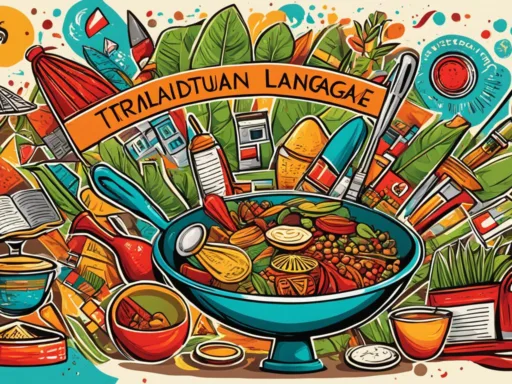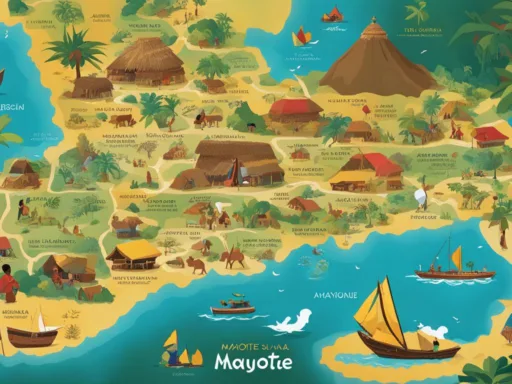Imagine a gastronomic adventure where ancient traditions blend seamlessly with a rich tapestry of cultural influences. Have you ever wondered how the heritage of a nation is reflected in the flavors of its dishes? A Turkmen Culinary Tour invites you to unearth the culinary secrets of Turkmenistan, a land where diverse dishes are more than a feast for the palate—they’re a narrative of history and harmony. Embark on a Turkmenistan food tour and revel in an array of tastes that interlace Persian artistry, Russian robustness, Central Asian zest, and Middle Eastern aromas. Every bite on this journey through the rich cuisine of Turkmenistan is a testament to a heritage steeped in cross-cultural interactions and gastronomic finesse.
Key Takeaways
- Uncover the unique blend of Persian, Russian, Central Asian, and Middle Eastern influences that shape Turkmenistan’s varied gastronomy.
- Experience the diversity within Turkmen cuisine, from aromatic traditional dishes to tantalizing street foods.
- Learn how the rich cuisine of Turkmenistan reflects the country’s history and cultural exchanges.
- Prepare yourself for an immersive Turkmen Culinary Tour that promises a voyage of mouthwatering discoveries.
- Gain insights into why a Turkmenistan food tour is an essential experience for any devoted culinary explorer.
The Tapestry of Turkmen Cuisine: An Introduction
Turkmenistan’s gastronomic landscape is a colorful patchwork quilt, intricately stitched with the vibrant threads of Central Asian traditions and Middle Eastern influences, creating a fabric that wraps around your taste buds with warmth. The nation’s proud culinary exploration stands as a testament to its rich cultural heritage, yielding a trove of authentic Turkmenistani dishes that both invite curiosity and promise delectable satisfaction.
The Intersection of Central Asian and Middle Eastern Traditions
The culinary artistry of Turkmenistan is a reflection of the intersecting caravans of flavor and technique that have traversed this heartland. The interplay between neighboring tastes and native concoctions has birthed a delightful array of dishes, where every spice and herb tells a tale of ancient trade routes and cultural convergence.
Key Ingredients Shaping Turkmenistan’s Culinary Identity
At the foundation of Turkmenistan’s culinary identity lies a symphony of staple ingredients that articulate both tradition and terrain. Aromatic rice pilafs, succulent lamb stews, and richly flavored steamed dumplings all boast the earthy essence of fresh herbs, yogurt zests, and a confetti of spices that pay homage to this Central Asian hub’s bountiful produce.
Exploring the Culinary Delights of Ashgabat, Mary, and Turkmenabat
From the urban sprawl of Ashgabat to the historic silk roads winding through Mary, and the dynamic bustle of Turkmenabat, these cities stand as beacons for the gastronomic explorers. Here, the culinary narrative unfolds through the meticulous preparation of Manti, the unleavened delight of gözleme, and the aromatic cauldron of stews that embody the spirit of Turkmen craftsmanship.
Turkmen Culinary Tour: A Pathway to Authentic Turkmenistani Dishes
Unveiling the essence of Turkmen cuisine experience isn’t complete until one has embarked on a culinary journey that paves the way to the heart of Turkmen gastronomy. The adventure leads us through diverse, piquant lanes where each turn is perfumed with the authentic flavors of Turkmenistan’s traditional food. Such a tour affords a genuine peek into local kitchens, where generations have honed techniques that today, weave together the story of a nation’s palate.
Imagine sampling the golden-brown layers of the Ashgabat Pilaf, the fragrance of its spiced rice and tender lamb spreading through the bustling bazaar. Or contemplate the warmth of Manti, steam rising from dumplings filled with perfectly seasoned meats. Eager food explorers will also revel in the crunch of gözleme, as it breaks away to reveal savory fillings, each bite a testament to Turkmenistan’s culinary craft.
Below is a table that encapsulates some of the must-try dishes on a Turkmen culinary tour:
| Dish | Main Ingredients | Occasion | Taste Profile |
|---|---|---|---|
| Ashgabat Pilaf | Rice, lamb, carrots, spices | Festive and daily meals | Rich, savory with a hint of sweetness |
| Manti | Meat, dough, yogurt | Family gatherings | Savory with creamy yogurt complement |
| Gözleme | Flour, spinach or cheese or meat | Snacks or light meals | Varies by filling, generally savory |
These dishes not only delight the palate but also embrace the warmth of the Turkmen hospitality, making visitors feel right at home. A Turkmen culinary tour is not just a dining experience; it’s a vibrant parade of tastes, shared over tales old as time, in a setting resonant with history and flavor intertwined.
The journey through Turkmenistan’s cuisine is an intimate dance of tradition and taste, leaving an indelible imprint on the hearts and taste buds of travelers from near and far. There’s no better way to understand a culture than through the vessel of food, where each ingredient, each spice, and every preparation tells a story — a tale woven in the fabric of Turkmen rich culinary heritage.
Flavors of Turkmenistan: Popular Dishes and Regional Specialties
Embark on a palatable journey through the regional dishes of Turkmenistan, where centuries-old traditions have fostered a truly diverse flavors palette. Every meal is an opportunity to explore the historical crossroads of Asia and the Middle East, with recipes passed down through generations gracing traditional dinners and enlivening the everyday dining experience.

Ashgabat Plov: A Celebration of Rice and Lamb
Ashgabat Plov, the quintessence of Turkmen culinary pride, brings together tender lamb and aromatic long-grain rice. It’s a dish steeped in conviviality, often at the center of festive gatherings and representing a symphony of flavors unique to Turkmen culture.
Manti, Beshbarmak, and Gözleme: A Diversity of Flavors
Expanding the array of Turkmen delights, Manti unveils the secrets of spice-infused meat ensconced within delicate dough, while Beshbarmak impresses with its robust pasta ribbons and a touch of garlic, and Gözleme tantalizes with its crispy exterior, enveloping a savory filling.
Shurpa and Qovurma: The Heartiness of Turkmen Stews
Savory stews are the cornerstone of hearty eating in Turkmenistan. Shurpa, with its nourishing broth, and Qovurma, a beloved stew brimming with rich flavors, highlight the skill of melding simplicity with richness, a true hallmark of Turkmen culinary wizardry.
| Dish | Main Ingredients | Occasion |
|---|---|---|
| Ashgabat Plov | Lamb, Rice, Carrots, Spices | Celebrations, Family Gatherings |
| Manti | Seasoned Meat, Dough, Yogurt | Weekend Lunches, Special Dinners |
| Beshbarmak | Pasta, Meat, Onion, Garlic | Traditional Feasts |
| Gözleme | Flour, Filling (Cheese, Spinach, or Meat) | Quick Meals, Street Food |
| Shurpa | Meat, Vegetables, Broth | Cold Winter Days |
| Qovurma | Lamb, Onions, Peppers, Tomatoes | Festive Occasions |
Whether it’s the ubiquitous Turkmen kebabs or the venerated Ashgabat Plov, the dishes that define Turkmen cuisine carry the spirit of the Silk Road and the warmth of the Turkmen people. It is an experience that reaches beyond taste, embedding itself in the rich tapestry of Central Asian culinary tradition.
The Sweet Side: Unveiling Turkmenistan’s Desserts
When it comes to the dessert scene in Turkmenistan, the variety and richness are astounding. The country’s Turkmenistani desserts blend the textures and flavors unique to Central Asian culinary art. One such beloved treat is Sütma rice pudding, a traditional dessert that brings forward the velvety essence of milk intensified with the nuttiness of almonds and pistachios. It’s a celebration of simplicity and flavor, offering a glimpse into the heart of Turkmenistan’s dessert traditions.
Sweet pastries take their rightful place in Turkmen kitchens with the flaky layers of honey-drenched Baklava and the sweet, doughy embrace of Turkmen Helva. These pastries are not just food items; they’re an integral part of the festivities and social gatherings. Intricately prepared by skilled hands, they stand as a testament to Turkmenistan’s thriving dessert traditions.
| Dessert | Main Ingredients | Occasions |
|---|---|---|
| Sütma Rice Pudding | Rice, milk, sugar, nuts | Celebrations, family gatherings |
| Turkmen Helva | Flour, butter, sugar syrup, saffron | Festivals, weddings |
| Baklava | Filo pastry, honey, nuts | Nowruz bayram, special events |
The allure of these traditional desserts goes beyond mere taste; it’s a cultural journey that touches upon the sweetest elements of Turkmen heritage. Each bite tells a story—a story of gatherings, of shared joy, and of a sweetness that lingers not just on the palate but in the memories they create. To partake in Turkmenistan’s desserts is to indulge in more than just a sweet ending to a meal; it’s to engage in a centuries-old legacy that continues to thrive at the tables of Turkmen families.
Turkmen Cuisine Experience: Snacking and Street Food Culture
Embark on a flavorful journey through the bustling lanes and vibrant markets of Turkmenistan that brim with the aromas and sounds of Turkmen street food culture. Here, local Turkmen recipes offer more than just sustenance; they are a symphony of tastes that define everyday life. Indeed, the rows of vendors with their grills and steamers invite locals and travelers alike to indulge in savored snacks that provide a peek into the soul of Turkmen society.

A casual stroll will lead to the discovery of an assortment of culinary delights of Turkmenistan, from succulent kebabs, sizzling on skewers, to deliciously filled gözleme, crisped to perfection. And not to be overlooked, the echpochmak, a savory pastry that envelops meat and spices within its flaky embrace, offering a filling treat for the peckish wanderer.
The table below outlines some of the most popular street foods you’ll encounter on your culinary exploration of Turkmenistan’s rich streets.
| Dish | Description | Common Ingredients |
|---|---|---|
| Kebab | Grilled meat skewer often served with fresh onions and bread. | Lamb, chicken, beef, onions, spices |
| Gözleme | A stuffed flatbread that can be savory or sweet, cooked on a griddle. | Flour, water, fillings (cheese, spinach, potato, or ground meat) |
| Echpochmak | A triangular pastry filled with meat and often referred to as ‘Turkmen pizza’. | Dough, minced meat (lamb or beef), onion, potato, spices |
With each bite, not only are the flavors appreciated, but also the heritage of a nation where every snack tells a story, and every bite is an experience to remember. Be sure to immerse yourself fully by sampling these humble, yet profoundly savored snacks and dive deep into the heart of Turkmen street food culture.
Culinary Exploration in Turkmenistan: Cooking Techniques and Dining Customs
The rich culinary traditions of Turkmenistan transcend mere sustenance, embodying the country’s strong sense of community and hospitality. Diving into these eating habits is as much about experiencing the local way of life as it is about the flavors on the plate. Turkmen gastronomy revolves around elaborate dining experiences and communal meals, settings in which guests are treated with renowned Turkmen hospitality.

Communal Feasts: The Cultural Significance of Shared Meals
Shared meals are not just occasions to eat; they are the fabric of Turkmen society. Historically, communal feasts in Turkmenistan have acted as conduits for social gatherings, bringing together family, friends, and even strangers. The act of sharing a meal around a dastarkhan (traditional Turkmen spread) is considered a sacred duty to hospitality, deeply ingraining the values of kinship and generosity.
From Chorek to Chai: Food Pairings and Beverage Traditions
In Turkmen gastronomic practice, certain food pairings are quintessential. Chorek, a soft and round bread, is traditionally shared among diners, torn by hand and never cut with a knife. Served with nearly every meal, it is a symbol of sustenance and unity. Accompanying the solid eats is the omnipresent chai, a subtle nod to the Turkmen preference for savoring meals with a hot beverage that offers both warmth and hospitality.
| Meal Component | Description | Cultural Relevance |
|---|---|---|
| Chorek | Traditional Turkmen bread | Served at every meal, represents hospitality |
| Chai | Hot tea, often green or black | Symbolizes warmth, enjoyed throughout the day |
| Pilaf | Rice dish with lamb, carrots, and spices | Staple for celebrations and large gatherings |
| Manti | Steamed dumplings filled with meat | Common in family meals, served with yogurt |
Exploring the culinary traditions of Turkmenistan means engaging with these practices and embracing the Turkmen spirit of togetherness that thrives over shared dining experiences and the cultural appreciation for communal meals.
Best Food in Turkmen: A Guide to Must-Try Local Favorites
Embarking on a culinary voyage in Turkmenistan is to taste the very essence of Central Asian gastronomy. The best food in Turkmen is a reflection of its vibrant culture and the hearty appetite of its people. Each dish tells a story, each flavor a legacy of the Silk Road, creating a memorable taste of Turkmenistan for any traveler.
Among the rich tapestry of local favorites, certain dishes stand tall as culinary highlights of any food lover’s journey. The Ashgabat Pilaf, for instance, is a masterclass in flavor and texture, blending rice, carrots, and hunks of tender lamb into a harmonious whole. But Turkmen cuisine is not just about the Pilaf; it’s a realm filled with a variety of must-try delights.
- Shashlik kebabs – Grilled to perfection, these skewers of succulent meat are a testament to the Turkmen love for well-seasoned, charcoal-cooked dishes.
- Qovurma – A lamb stew that is rich in onions and spices, stewed to a point where every spoonful is a warming, savory sensation.
- Gözleme – Stuffed with a mixture of spinach, cheese, or potatoes, this flatbread is pan-fried to achieve a crispy texture, offering a delightful contrast to its soft, flavorful filling.
One cannot discuss the taste of Turkmenistan without extolling its myriad kebabs and meats, an integral part of the national food culture. However, the gastronomic experience here is balanced with light, refreshing salads and an assortment of dairy products, including the ever-present yogurt sides which bring a cooling complement to the table.
For those seeking an adventure through taste, an exploration of Turkmen cuisine is a journey of discovery, with each meal bringing you closer to the heart of this fascinating country. So when you find yourself under the grand Turkmen sky, remember to indulge in these culinary highlights—each bite a chapter in the story of this enchanting land.
Taste of Turkmenistan: An Exploration of Local Beverages
Immersing in the Turkmen cuisine experience extends to savoring the unique local beverages that embody the essence of Turkmen hospitality and tradition. Among these, two standout drinks offer complementary aspects of the nation’s palette: the fermented yogurt drink known as Dough and the culturally beloved traditional tea, or chai. Both serve as refreshing counterparts to the rich and diverse dishes found in Turkmenistan.
Dough: Fermented Yogurt Drink
Integral to capturing the authentic flavor of Turkmenistan, Dough is as refreshing as it is traditional. This tangy fermented yogurt drink not only quenches thirst but also plays a pivotal role in the Turkmen diet, often accompanying meals, especially during the heat of the summer months. Here’s how Dough harmonizes with local dishes:
- Dough and Pilaf: Enhances the rich flavors of the lamb and rice.
- Paired with Kebabs: Offers a cooling balance to the smoky taste of grilled meats.
- With Gözleme: Cuts through the richness of these stuffed flatbreads.
Traditional Tea Culture: Importance of Chai in Turkmen Society
Traditional tea, or chai, is more than just a beverage in Turkmenistan—it’s a symbol of community and social interaction. It’s common to see families and friends gather around a pot of chai, sharing stories and hospitality. Chai is omnipresent throughout the day, from morning reflections to evening soirees.
| Chai in Turkmen Society | Details and Practices |
|---|---|
| Morning Ritual | A cup of chai starts the day with warmth and tranquility. |
| Afternoon Gatherings | Served with pastries, complementing the sweetness with its robust flavor. |
| Evening Relaxation | Concludes the day as a comforting tradition, often after dinner. |
Visitors looking for an authentic Turkmen cuisine experience will find that local beverages like Dough and traditional tea are not just simple refreshments but keynotes in the symphony of flavors that Turkmen cuisine plays, a testament to the region’s rich cultural tapestry.
Conclusion
The culinary fabric of Turkmenistan is a vibrant blend of time-honored recipes and evolving gastronomic practices. As Turkmenistan continues to open its doors to the world, the commitment to its Turkmen culinary heritage becomes even more vital. The task at hand is not just about maintaining the past but also embracing the future. By intertwining the art of preserving traditions with the acceptance of new palates and preferences, such as incorporating Greek yogurt into classic dishes, Turkmenistan’s culinary identity remains robust and dynamic.
Preserving Traditions: The Future of Turkmen Cuisine
At the core of Turkmen gastronomy is the spirit of its people, solidly grounded in a legacy of shared meals and the generous nature of Turkmen hospitality. This spirit fosters a sense of continuity that is crucial for the preservation of a rich and multi-dimensional culinary landscape. Culinary journeys into the heartland offer a window into this world where authentic Turkmenistani dishes and the custom of communal dining present a tapestry woven with the threads of historical flavors and contemporary innovations.
Embark on Your Own Culinary Journey in Turkmenistan
For the epicurean adventurer, Turkmenistan is a destination ripe for exploration. Each traveler carries the potential to become an ambassador of Turkmenistan’s gastronomic story, discovering and sharing the wealth of tastes that this land has to offer. From city bazaars to rural feasts, authentic Turkmenistani dishes serve as savory narratives waiting to be experienced. As these culinary journeys unfold, they not only contribute to the gastronomic tapestry of Turkmenistan but also ensure that its storied traditions are secured for tomorrow’s tables.






